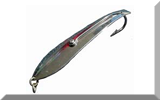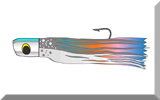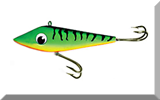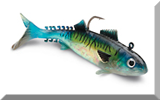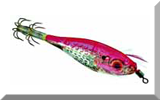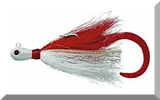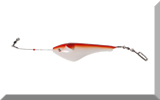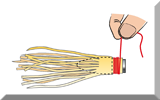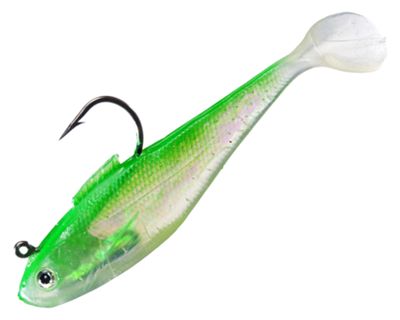Are Soft Plastic Swimbaits the Ultimate Saltwater Fishing Lure
So what exactly are swimbaits Well, they can be loosely defined as saltwater fishing lures that closely resemble the baitfish they are intended to imitate - not just in appearance but in swimming action too.
Although by this definition they include hard-bodied plugs and crankbaits, when saltwater fishermen talk about swimbaits they're normally referring to soft plastic fish-like lures, and it's these lures (which are also known as shads and pogies) that we'll feature on here.
Some are designed specifically for trolling from a boat and others for casting from the shore - and some can be used for both.
They get their life-like swimming action from their flexible bodies and flat endplate design of their tails. These 'paddle-tails' wriggle frantically sending out both vibrational and visual alarm signals to any nearby predator.
Although much less durable than their hard-moulded cousins, they do have one significant advantage over them, and this is it...
When a predator grabs hold of a hard plug he immediately realises his mistake and does his best to get rid of it in a hurry.
Not so, with a soft plastic lure.
The predator is much more likely to be fooled for a little longer, maybe even taking a second gulp, in doing so giving the angler a better chance of a good hook hold.
Swimbaits come in three general forms:~
- Fully rigged one-piece versions, and
- Un-rigged two-piece versions
Pre-Rigged Swimbaits
These are manufactured as a complete unit with an integral hook and an encapsulated weighted head, and there are literally hundreds to choose from. Some are very effective lures and others are much less so, and telling one from the other is not possible from its appearance.
Like any other lure, it's its action that's important - not how appealing it looks to us. But find one with a realistic action and a convincing appearance then you're likely to be on to a winner.
Of particular importance are the eyes, as it's these that give the predator something to home in on.
Un-Rigged Swimbaits
These come as two separate components:~
- A jig head incorporating a rigidly attached hook, and
- a soft plastic body, which is easily and cheaply replaced
Given the durability issue with soft plastic lures generally, the commercial attractiveness of two-part unrigged swimbaits (or 'leadheads' as they're known in the UK) is pretty obvious, but the downside is that unless the assembly of head and body is done with precision their swimming performance will be compromised, along with their ability to fool a fish.
Although the barb behind the head part of the jig head goes a long way towards preventing the flexible body from sliding aft and bunching up around the hook, it's not always entirely successful.
Solution ~ A dab of super-glue between the front end of the body and the aft end of the head!
Some of these softbaits are impregnated with a fish-attracting scent.
Shore Fishing with Swimbaits
If I'm shore fishing with these lures, the odds are that sea bass are my target. And it will usually be over rough ground, probably a from rock fishing mark and there'll be some tide running.
If the water is deep, say 30 to 40 feet, heavier lures of around 5" to 6" will get the lure down before the current swings it around. The smaller 3" to 4" lures will be fine for shallow water. As with all kinds of lure fishing, experimentation is the key as far as the retrieve is concerned. Stop, start, slow the retrieve rate right down, then speed it up, try a steady rate of retrieve, lift the rod tip up, drop it down and so on. Sooner or later you'll find what works - then do it again...
A good quality, light spinning rod will form the basis of your outfit, together with a fixed spool reel loaded with braided fishing line and topped of with a fluorocarbon leader. Why braid line ~ Well...
- Braid takes up much less space on the spool, which allows you to use a smaller, lighter reel than you'd have to with mono line.
- No other line type transmits the vibrations of the lure to the angler like braid does. You'll feel the strumming of the paddle-tail, along with every little knock on the lure. If you react quickly enough, you'll be able to lift the lure clear of a rocky bottom before you get terminally hung up.
And why a fluorocarbon leader rather than the much cheaper nylon monofilament ~ Because fluorocarbon is virtually invisible under water, and with bass you need all the help you can get.
Trolling with Swimbaits
Most swimbaits are primarily intended for casting but some work equally as well when trolled slowly astern of a moving boat.
Trolled too quickly swimbaits with paddle-tails will either spin or capsize, immediately losing all fish-catching ability. I always experiment by trolling the lure close astern to find out at what speed this happens - and then go slower!
If you make a note of this speed for future reference, remember that it must be boat speed through the water not over the ground. This means that the speed reading given by your GPS set is of no use to you, unless there's no tidal current at all. But a paddle-wheel (or thru-hull) log will give the speed through the water at any stage of the tide.
This enables these lures to be trolled at 6 knots for the 7" mackerel and 9 knots for the 10" version.
Williamson Lures produce a range of these 'Live Series' lures which are amazingly lifelike both in appearance and action.
Each lure in the series resembles a specific baitfish - Ballyhoo, Atlantic Mackerel, Spanish Mackerel, Little Tunny, Bunker (aka Shad, Pogy or Menhaden), Mullet, Ribbonfish and Squid - and is produced in several sizes.
They certainly catch fish, but like all soft-plastic lures, robustness isn't one of their selling points. Whilst you may get several good tuna or dorado on a 'Live Series' ballyhoo, one strike from a wahoo and it may well be 'game-over' for that lure. But you've got your fish... |
